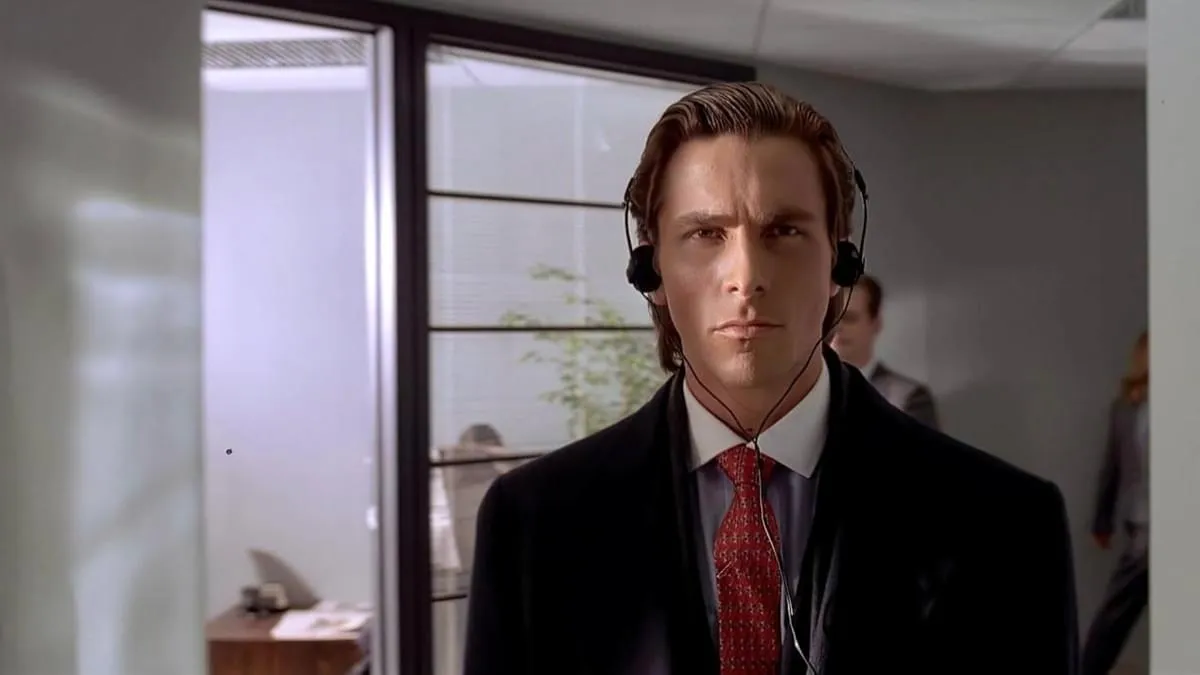Mary Harron’s American Psycho, adapted from Bret Easton Ellis’s controversial novel, is one of the most unsettling yet darkly comic films to emerge from the turn of the millennium. Set in the opulent but soulless world of late-1980s Wall Street, it follows Patrick Bateman a wealthy investment banker whose obsessive grooming routines and brand-name perfection hide a chillingly violent double life. Or do they?
More than just a stylish horror-satire, the film is a sharp critique of consumerism, toxic masculinity, and the fragility of identity in a culture obsessed with appearances. It leaves audiences questioning what’s real, what’s imagined, and whether anyone in Bateman’s world is truly paying attention.
The Plot: A Glimpse Into Patrick Bateman’s Perfectly Curated Madness
Patrick Bateman (Christian Bale) is the archetypal 1980s yuppie—handsome, fit, wealthy, and meticulously put together. By day, he works at Pierce & Pierce, surrounded by equally polished colleagues. By night, he appears to indulge in brutal acts of murder, targeting homeless men, rival businessmen, and women he lures into his apartment.
Yet, the more the film progresses, the more inconsistencies emerge. Bateman’s killings are sometimes witnessed without consequence, his confessions are brushed off, and people he claims to have murdered—like Paul Allen (Jared Leto) are later seen alive. By the end, we’re left wondering whether the violence happened at all or existed only in Bateman’s mind.
Patrick Bateman’s Duality: Polished Mask vs. Primal Instinct
Bateman is a man split in two: his outer shell is a socially acceptable mask of wealth and charm; his inner world is rotting with insecurity, rage, and a hunger for dominance. This duality is mirrored in his obsessive daily routine: he treats his body as a luxury product to be maintained, just like his designer suits and imported skincare.
His “mask of sanity” echoes a theme from classic literature, notably Dr. Jekyll and Mr. Hyde, in which the respectable facade hides an unrestrained, darker self. In Bateman’s case, the mask is so convincing that even his most extreme confessions fail to shatter it in the eyes of those around him.
Critique of 1980s Consumerism and Masculinity
The film skewers the shallow materialism of Wall Street culture—Bateman and his peers compete over business cards, compare reservation statuses at elite restaurants, and mistake each other’s identities because they’re virtually interchangeable in appearance and demeanor.
This competitive vanity is intertwined with a hyper-masculine ideal—success is measured not in moral worth or human connection, but in power, status, and possessions. Bateman’s violence becomes an exaggerated, grotesque extension of this mindset: if your worth is defined by dominance, why not take it to its most literal, brutal form?
Key Scenes That Blur Reality and Delusion
The Business Card Scene: Ostensibly about stationery, it’s a masterclass in satire. The men’s obsession over paper texture and font is played with the intensity of a war drama, revealing their fragile egos. For Bateman, it triggers a barely concealed existential rage.
Paul Allen’s Murder: Bateman lures Allen to his apartment with the promise of drinks and music (Huey Lewis & the News), then kills him with an axe. The scene is absurdly theatrical, yet later events suggest Allen may still be alive.
The ATM and the Cat: Near the climax, Bateman hallucinates an ATM telling him to “Feed me a stray cat,” pushing the narrative fully into surreal territory.
The Final Confession: Bateman calls his lawyer, hysterically confessing to countless murders. But when they meet the next day, the lawyer laughs it off, insisting Bateman couldn’t have killed Allen—he had dinner with him recently.
Were the Crimes Real or Imagined?
The ambiguity is the point.
Arguments for “Real”: Some killings are witnessed by the audience in a direct, matter-of-fact way. Bateman’s fear and urgency in hiding evidence suggest real consequences.
Arguments for “Imagined”: The implausible scale of his “body count,” the survival of supposedly dead characters, and the surreal tone of certain scenes hint at psychosis.
Middle Ground: The film might be less concerned with literal truth and more with psychological truth—Bateman’s fantasies are real to him, whether or not they occurred physically.
The Ending: Guilt, Ego, and Societal Indifference
Bateman’s final voiceover is chilling: “This confession has meant nothing.” Whether he committed the murders or not, it doesn’t matter—nobody cares enough to notice. In a society where identity is shallow and interchangeable, even violent acts fail to register if they disrupt the polished facade.
This conclusion suggests guilt is irrelevant without consequences, ego survives exposure if no one’s paying attention, and indifference is the ultimate horror. The real terror isn’t that Bateman gets away with murder—it’s that his world is so self-absorbed, no one would stop him even if they knew.
If You Liked American Psycho, You Might Enjoy…
Film: The Wolf of Wall Street (2013) – A hedonistic look at greed and excess with a darkly comedic edge.
Film: Fight Club (1999) – Another unreliable narrator grappling with identity and consumerism.
Book: Less Than Zero by Bret Easton Ellis – A similarly cold, detached look at wealthy youth and moral emptiness.
Film: Taxi Driver (1976) – A psychological descent into alienation and violence.
